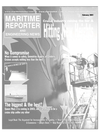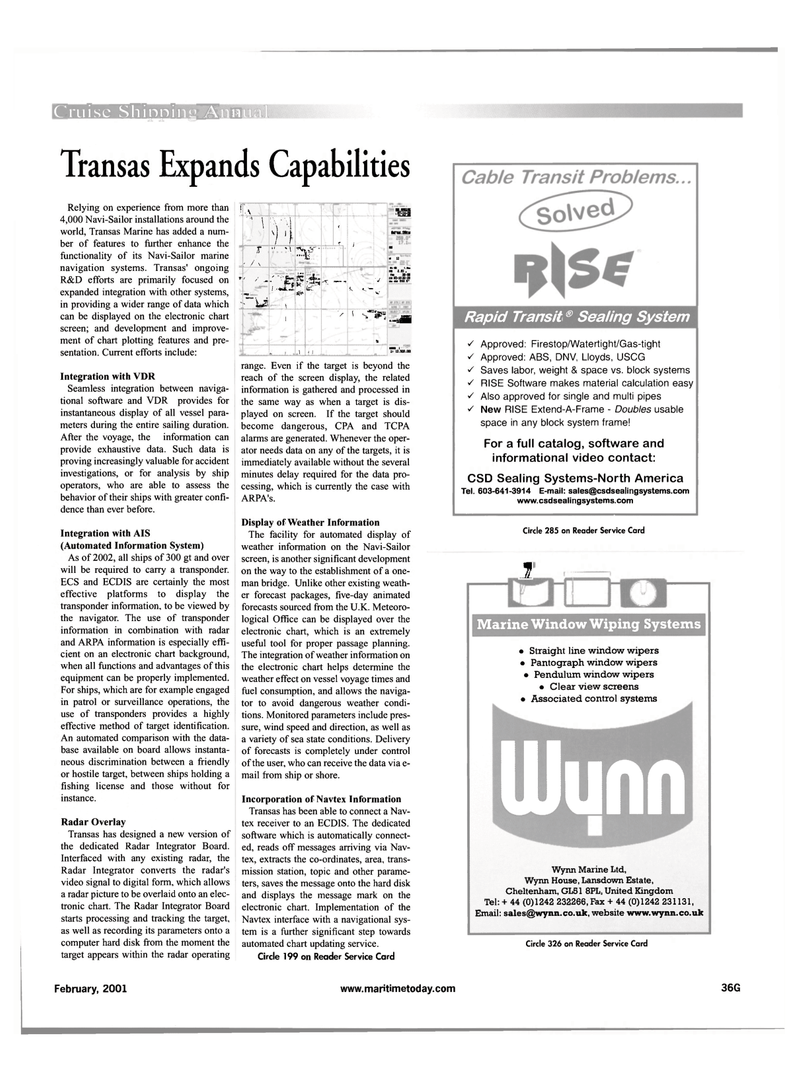
Page 43: of Maritime Reporter Magazine (February 2001)
Read this page in Pdf, Flash or Html5 edition of February 2001 Maritime Reporter Magazine
Cruise Shinniniz Annual
Transas Expands Capabilities
Relying on experience from more than 4,000 Navi-Sailor installations around the world, Transas Marine has added a num- ber of features to further enhance the functionality of its Navi-Sailor marine navigation systems. Transas' ongoing
R&D efforts are primarily focused on expanded integration with other systems, in providing a wider range of data which can be displayed on the electronic chart screen; and development and improve- ment of chart plotting features and pre- sentation. Current efforts include:
Integration with VDR
Seamless integration between naviga- tional software and VDR provides for instantaneous display of all vessel para- meters during the entire sailing duration.
After the voyage, the information can provide exhaustive data. Such data is proving increasingly valuable for accident investigations, or for analysis by ship operators, who are able to assess the behavior of their ships with greater confi- dence than ever before.
Integration with AIS (Automated Information System)
As of 2002, all ships of 300 gt and over will be required to carry a transponder.
ECS and ECDIS are certainly the most effective platforms to display the transponder information, to be viewed by the navigator. The use of transponder information in combination with radar and ARPA information is especially effi- cient on an electronic chart background, when all functions and advantages of this equipment can be properly implemented.
For ships, which are for example engaged in patrol or surveillance operations, the use of transponders provides a highly effective method of target identification.
An automated comparison with the data- base available on board allows instanta- neous discrimination between a friendly or hostile target, between ships holding a fishing license and those without for instance.
Radar Overlay
Transas has designed a new version of the dedicated Radar Integrator Board.
Interfaced with any existing radar, the
Radar Integrator converts the radar's video signal to digital form, which allows a radar picture to be overlaid onto an elec- tronic chart. The Radar Integrator Board starts processing and tracking the target, as well as recording its parameters onto a computer hard disk from the moment the target appears within the radar operating : A .. 3 i f\ f « 1
H-M.SU m t -r / \ gyS ' w 12
SL-K I.Bn Kit 0.63 , m 39.08
Et« 20-1022.22 Ml CM 250.8* r/ / M • —1? fV " J5 i
S
Sffr ti—, p* rX - v «•••- 'J/ • v.- i V I s* Sr? % an« [S « i ,, .1 i,J. m. T*12!MO,OM range. Even if the target is beyond the reach of the screen display, the related information is gathered and processed in the same way as when a target is dis- played on screen. If the target should become dangerous, CPA and TCPA alarms are generated. Whenever the oper- ator needs data on any of the targets, it is immediately available without the several minutes delay required for the data pro- cessing, which is currently the case with
ARPA's.
Display of Weather Information
The facility for automated display of weather information on the Navi-Sailor screen, is another significant development on the way to the establishment of a one- man bridge. Unlike other existing weath- er forecast packages, five-day animated forecasts sourced from the U.K. Meteoro- logical Office can be displayed over the electronic chart, which is an extremely useful tool for proper passage planning.
The integration of weather information on the electronic chart helps determine the weather effect on vessel voyage times and fuel consumption, and allows the naviga- tor to avoid dangerous weather condi- tions. Monitored parameters include pres- sure, wind speed and direction, as well as a variety of sea state conditions. Delivery of forecasts is completely under control of the user, who can receive the data via e- mail from ship or shore.
Incorporation of Navtex Information
Transas has been able to connect a Nav- tex receiver to an ECDIS. The dedicated software which is automatically connect- ed, reads off messages arriving via Nav- tex, extracts the co-ordinates, area, trans- mission station, topic and other parame- ters, saves the message onto the hard disk and displays the message mark on the electronic chart. Implementation of the
Navtex interface with a navigational sys- tem is a further significant step towards automated chart updating service.
Circle 199 on Reader Service Card
Rapid Transit ® Sealing System s Approved: Firestop/Watertight/Gas-tight • Approved: ABS, DNV, Lloyds, USCG
S Saves labor, weight & space vs. block systems s RISE Software makes material calculation easy s Also approved for single and multi pipes s New RISE Extend-A-Frame - Doubles usable space in any block system frame!
For a full catalog, software and informational video contact:
CSD Sealing Systems-North America
Tel. 603-641-3914 E-mail: [email protected] www.csdsealingsystems.com
Circle 285 on Reader Service Card 7
Marine Window Wiping Systems • Straight line window wipers • Pantograph window wipers • Pendulum window wipers • Clear view screens • Associated control systems
Ulunn
Wynn Marine Ltd,
Wynn House, Lansdown Estate,
Cheltenham, GL51 8PL, United Kingdom
Tel: + 44 (0)1242 232266, Fax + 44 (0)1242 231131,
Email: [email protected], website www.wynn.co.uk
Circle 326 on Reader Service Card
February, 2001 www.maritimetoday.com 36G

 42
42

 44
44
